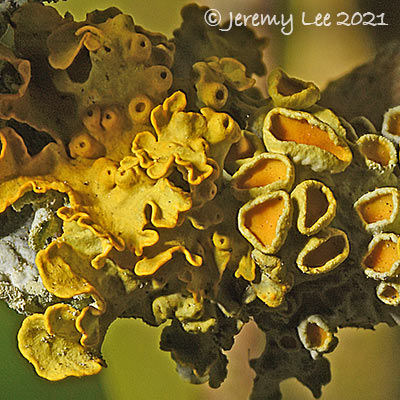
 |
|
Scientific Classifications explained » Amphibians » Ants » Aphids » Bees » Beetles » Birds » Bugs » Butterflies » Caterpillars » Damselflies » Dragonflies » Earwigs » Flies » Frog/Leafhoppers » Fungi » Galls » Grasshoppers » Harvestmen » Hoverflies » Lacewings » Ladybirds » Leaf Mines » Lichens » Mammals » Millipedes » Mosses » Moths » Sawflies » Slugs » Snails » Spiders » Trees & Shrubs » Wasps » Wild Flowers » Woodlice » Postboxes |
UK Nature > Lichens > Xanthoria parietina

Scientific Name: Xanthoria parietina Common Name: Common Orange Lichen Xanthoria parietina is a foliose lichen forming large, rounded patches up to 10 cm across, with wide, round-lipped marginal lobes. The thallus is yellowish green to greenish grey in shade but bright orange in brightly lit situations. In older specimens the centre of the thallus may die out. Lobes are long, wrinkled, over-lapping, up to 7 mm wide at the margin, and often turn up to reveal a white underside with root-like hairs. Lobes may be narrow in exposed conditions such as on the seashore. Fruiting bodies sit on the surface of the thallus and are composed of an orange disc with a paler margin, which may become crenulate. Fruiting bodes are most abundant in the centre of the thallus. Xanthoria parietina may form a distinct narrow band on rocks and walls just above high water level. It also occurs inland on rocks, walls and bark. Common on nutrient rich areas such as beneath bird perching areas. Widespread across the British Isles, inland but commonest near the coast. |
|

https://www.uknature.co.uk is a website dedicated to showing the immense diversity of UK nature and wildlife. Our vast range of habitats, from lowland arable to snow covered mountains, from storm-ravaged coastlines to peaceful inland freshwater lakes and rivers, from dry, sandy heaths to deciduous and coniferous forests, all these habitats contribute to the abundance of UK nature. We have wild birds in huge numbers either residing or visiting our shores (597 recorded species as at July 2013) and we must also not forget the humble back garden with its grass lawns, flower beds filled with nectar rich flowers, shrubs and trees, all designed to attract huge numbers of insects such as bees, moths, butterflies and hoverflies; and finally the small ponds which provide safe havens for frogs, toads, newts and even slow worms and grass snakes. www.uknature.co.uk is the showcase for my personal passion, photographing uknature in all its glory. I sincerely hope you all enjoy the fruits of my labours. This site and all images contained therein is © Jeremy Lee 2004 - 2025. All Rights Reserved. Site design by Jeremy Lee. Site development & IT Support by Stuart Lee. |